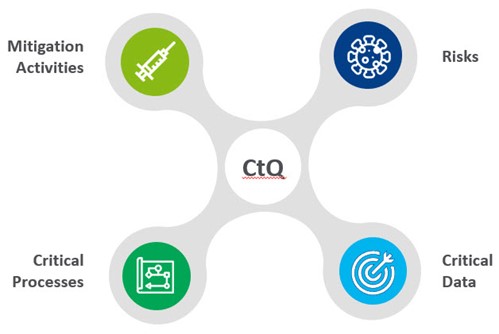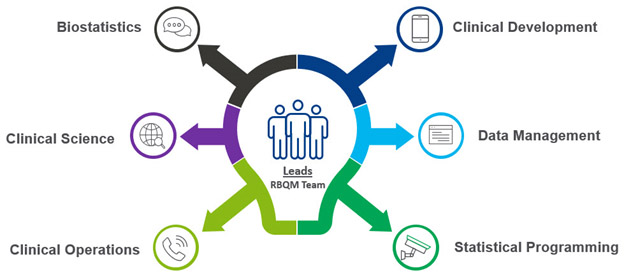Using Critical To Quality (CtQ) Factors To Identify The Critical Data For RBQM
By Kevin Douglass, associate director, RBQM; Jehan Poco, associate director, BDM functional excellence; and Terry Katz, senior director, biostatistics and data management planning and functional excellence, Daiichi Sankyo

Risk-based monitoring was the initial foray into a risk-proportionate approach to quality management. This scope broadened and became more prominent with ICH E6(R2) and continues in the draft version of ICH E6(R3). Commonly called risk-based quality management (RBQM), it has triggered numerous and varied approaches to reducing site, CRO, and sponsor burdens in monitoring, and at the same time improving quality (i.e., subject safety and data reliability).
Transitioning from guidance (regulatory and industry) to action (operationalization via effective and efficient processes) has been challenging. This paper describes a starting point based on ICH E8(R1) quality by design (QbD) principles and the use of critical to quality (CtQ) factors to identify critical data (forms and variables) that focuses the end-to-end RBQM process on “what matters” to the safety of trial subjects and the credibility of the results.
Background
A 2013 TransCelerate position paper1 introduced the philosophy that fixed schedule, on-site prescribed monitoring could be improved by using a more holistic and proactive approach combining off-site central monitoring and targeted on-site monitoring. Later, ICH E8(R1)2 stated in section 3.2, “A basic set of factors relevant to ensuring study quality should be identified for each study. Emphasis should be given to those factors that stand out as critical to study quality.” Predefining CtQ factors at the portfolio level drives an optimal and consistent approach to RBQM that complies with the quality by design (QbD) principles and establishes a strategy for identifying study-specific critical data, critical processes, risks, and mitigation activities. Concerning the critical data specifically, the result is a (markedly) smaller and more focused number of critical forms and variables than those produced using other approaches (e.g., using the schedule of events in the protocol). The focus then is on “data that matters,” which can then be reinforced during protocol development, the risk assessment, and in all functional plans for a holistic and aligned approach.
Each sponsor or CRO can define focal areas that constitute CtQ. ICH E6(R2)3 section 5 and ICH E6(R3 draft)4 section 3.10 state quality management expectations to identify critical variables and processes, perform risk evaluations, establish risk control, communicate, and report. It is implied you should follow these actions primarily using the critical data selected according to the QbD and CtQ principles.
CtQ Factors
CTTI5 published a concept document that we used as a starting point for creating a CtQ framework and establishing our initial set of standard CtQs6. They are:
- Eligibility (qualified for enrollment)
- Stratification (variables used in the statistical analysis predefining subgroups)
- Treatment administration (administration of at least one dose, and compliance with subsequent dosing)
- Follow-up (participants followed per protocol to support analyses)
- Primary and key secondary endpoints (the basis for efficacy in the dossier and label claim)
- Safety/adverse events (serious AE or those of special interest)
- Biosamples (those supporting key endpoints)
The CtQs enabled the identification of quality tolerance limits (QTLs) with statistically derived upper and lower (warning) ranges. These were developed as mitigation activities associated with specific CtQs to monitor that enrollment yielded the right patients, that stratification and treatment assignment and receipt of correct test drug yielded the right treatments, and that due diligence regarding participant visits and a concentrated focus on the quality of endpoint data yielded the right data to assess primary and secondary efficacy and safety endpoints.

We identified the following benefits of a CtQ framework:
- Alignment with the ICH E8(R1) and draft ICH E6(R3) guidance
- Providing a context for selecting critical data and processes, identifying risks, and defining mitigation activities
- Establishing a continuum from protocol to risk assessment to functional plans
- Focusing risk mitigation (including site monitoring) on critical data enabling markedly reduced source document validation (SDV)
- Identification of critical data/variables that enable focused internal cross-functional data reviews and targeted source data verification (tSDV).
Current Status
With our initial set of CtQ factors defined and communicated, the biostatistics team developed a list of oncology-specific efficacy and safety endpoints with associated critical data. This triggered the formation of a cross-functional CtQ Working Group (led by the RBQM team and with participation from biostatistics, clinical, clinical operations, data management, and clinical safety) to review the initial list and identify the critical data for the standard CtQs. Using our standard eCRF library, the CtQ Working Group has successfully identified the critical data (forms and variables) for our CtQs. It took approximately two months from the formation of the CtQ Working Group to the finalization of the CtQ-associated critical forms and variables (but required a focused effort from the entire team).

Next Steps
The CtQ-associated critical data we identified can be implemented (e.g., by connecting it with study-specific data review activities and targeted SDV strategies) while we continue to build out our CtQ framework. We’ve identified other activities/deliverables to improve and fully operationalize it. Examples are listed below:
- Identify critical third-party/external data.
- Build a CtQ library (adding risks, critical processes, and mitigation activities to the critical data).
- Develop training and tools to enable study teams to utilize the CtQ library.
- Incorporate the same CtQ in all functional plans.
- Customize an initial CtQ set for other therapeutic areas.
Lessons Learned So Far
Although we are currently a work in progress, listed below are a couple of lessons we’ve learned along the way:
- Invest time in the beginning to develop and refine your concept of CtQ factors
- Socialize the CtQ factors with key stakeholders to improve them and build cross-functional support
- Develop a charter to align the team on what you will do when (recognizing it’s a living document)
- Develop an agile and structured approach to establish the right sequence that can be adapted as necessary.
- Collaboratively evaluate the CtQ framework’s impacts on existing processes for protocols, risk assessment, data review, clinical monitoring, etc.
- Conduct organizational change management activities for operational understanding, buy-in, and common implementation.
References:
- TransCelerate BioPharma Inc. Position Paper: Risk-Based Monitoring Methodology. TransCelerate BioPharma Inc; 30 May 2013
- International Council for Harmonisation of Technical Requirements for Pharmaceuticals for Human Use, General Considerations for Clinical Studies, E8(R1) (6 October 2021), https://database.ich.org/sites/default/files/E8-R1_Guideline_Step4_2021_1006.pdf, 6 October 2021, accessed 13 August 2024
- International Council for Harmonisation of Technical Requirements for Pharmaceuticals for Human Use, Integrated Addendum to ICH E6(R1): Guideline for Good Clinical Practice E6(R2), https://database.ich.org/sites/default/files/E6_R2_Addendum.pdf, 9 November 2016, accessed 13 August 2024
- International Council for Harmonisation of Technical Requirements for Pharmaceuticals for Human Use, Good Clinical Practice (GCP) E6(R3), draft 19 May 2023, accessed 13 August 2024
- CTTI Quality by Design Project-Critical to Quality (Ctq) Factors Principles Document, 2015 https://ctti-clinicaltrials.org/wp-content/uploads/2021/07/CTTI_QbD_Workshop_Principles_Document.pdf, accessed 13 August 2024
- Kevin Douglass and Jehan Poco, Critical to quality factors: a simple but powerful framework for risk-based quality management, Outsourcing in Clinical Trials East Coast, King of Prussia, PA; presentation 21 May 2024
About The Authors:
 Kevin Douglass is an associate director in risk-based quality management (RBQM) at Daiichi-Sankyo. The RBQM team partners internally (e.g., with biostatistics, clinical operations, data management, and clinical science/development) and externally with CROs and other service providers to optimize RBQM processes and tools including the identification of critical to quality factors, risk assessment, centralized monitoring, and risk-based site monitoring. RBQM team members are assigned at the drug program level but operate as RBQM leads at the study level.
Kevin Douglass is an associate director in risk-based quality management (RBQM) at Daiichi-Sankyo. The RBQM team partners internally (e.g., with biostatistics, clinical operations, data management, and clinical science/development) and externally with CROs and other service providers to optimize RBQM processes and tools including the identification of critical to quality factors, risk assessment, centralized monitoring, and risk-based site monitoring. RBQM team members are assigned at the drug program level but operate as RBQM leads at the study level.
Kevin has more than 40 years of industry experience working in various positions including data management, quality & compliance, and operational excellence and since 2016 has focused on RBQM. He is certified in Lean Six Sigma/Change Management and has led multiple cross-functional continuous improvement projects. He received his BS in biology from Ursinus College and MS in biology from Villanova University.
 Jehan Poco is an associate director in the biostatistics & data management functional excellence at Daiichi-Sankyo. Jehan partners with BDM and R&D teams on functional initiatives, system rollouts, and process development/refinement, as well as supporting key partners like the RBQM COE as a member.
Jehan Poco is an associate director in the biostatistics & data management functional excellence at Daiichi-Sankyo. Jehan partners with BDM and R&D teams on functional initiatives, system rollouts, and process development/refinement, as well as supporting key partners like the RBQM COE as a member.
Jehan has 19+ years of industry experience working for numerous companies in various positions (TMF, clinical monitoring, quality & compliance, operational excellence/change management, metrics/benchmarking, and RBQM). He received a BA in cell biology & neuroscience from Rutgers College, an MBS in biomedical science from the University of Medicine and Dentistry NJ (UMDNJ), and is certified in auditing and change management methodologies.
 Terry Katz is the senior director of biostatistics and data management planning and functional excellence at Daiichi Sankyo since 2020. He added the RBQM department in February 2024 and set a goal of internalization with technical expertise. Previously he was head of global data management and statistics at Merck Animal Health, VP of biometrics at ImClone Systems, senior manager of analysis & reporting for PRA International, and a statistician at Schering-Plough. He holds accreditation as a professional statistician and certifications as a quality engineer and a Six Sigma Green Belt. He is chair of DIA's GCP-QA Community; formerly, he was a core committee member of the NJ CDISC User Group and chair of the Statistical Taskforce for the Animal Health Institute. Terry also completed a 3-month fellowship in Kenya to improve the capacity and capability of the local hospitals to run oncology clinical trials.
Terry Katz is the senior director of biostatistics and data management planning and functional excellence at Daiichi Sankyo since 2020. He added the RBQM department in February 2024 and set a goal of internalization with technical expertise. Previously he was head of global data management and statistics at Merck Animal Health, VP of biometrics at ImClone Systems, senior manager of analysis & reporting for PRA International, and a statistician at Schering-Plough. He holds accreditation as a professional statistician and certifications as a quality engineer and a Six Sigma Green Belt. He is chair of DIA's GCP-QA Community; formerly, he was a core committee member of the NJ CDISC User Group and chair of the Statistical Taskforce for the Animal Health Institute. Terry also completed a 3-month fellowship in Kenya to improve the capacity and capability of the local hospitals to run oncology clinical trials.
